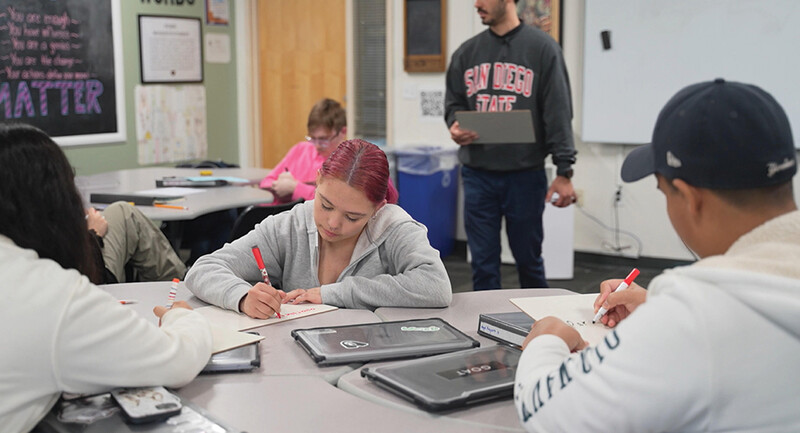September 1, 2023
•
5 min (est.)•
Vol. 81•
No. 1Boosting Sight Reading
Guiding secondary students to recognize and internalize complex words is key to accelerating reading skills.

Premium Resource
The average adult reads about 250 words a minute, meaning it should take about 4 minutes to read this column. But there are a few variables that will affect your rate—for example, the technical level of the content. Consider the winning word for the 2023 Scripps National Spelling Bee: psammophile, meaning an organism that thrives in sandy terrains. A botanist specializing in cacti could read that last sentence more quickly, while the rest of us had to slow down a bit to do the same. That's likely because psammophile is a sight word for the botanist, as it was for Dev Shah, the 8th grader who won the competition.
Secondary subjects are riddled with unfamiliar words that can trip up student readers. They must master words like telescope and osmosis, quotient and derivative, totalitarianism and theocracy. Although terms like these are often addressed through vocabulary instruction focused on defining words, they need to also become part of students' sight word bank. In other words, students need to be able to recognize words like these instantly when they read them.
One major challenge in education today is the gulf between reading-level expectations and actual student performance at a given grade level. For secondary students, time is running out in their academic careers—they only have a handful of years before graduation. Guiding them in strategically breaking down complex words can accelerate their informational reading skills and better prepare them for the future.
A sight word is any word that a reader can recognize instantly. Every reader has a unique bank of sight words at their disposal. Yours is likely somewhat different from that of an automobile mechanic or computer systems analyst. Sight word knowledge is a crucial contributor to reading comprehension as a factor in automaticity theory—the ability to read words quickly and accurately without slowing down to decode them. The more automatic the reading, the more brain bandwidth is available to focus on comprehension.
When we do not immediately recognize a word, we rely on decoding by sounding out an unfamiliar word letter by letter. You probably reverted to decoding when you got to psammophile in that earlier sentence. But now that we have used psammophile four times in a little over 300 words, the term is beginning its journey into your sight word lexicon. Sight word learning requires repetition. Even if you are not an educator, you might associate sight word learning with flashcard drills, which draw on a whole-word approach to lock in a visual representation of a word.
In addition to decoding and whole-word representation, knowledge of the derivation of an unfamiliar word can contribute to sight word knowledge. When asked to spell psammophile at the National Spelling Bee, Dev asked for the part of speech (noun); its origin (Greek); and its use in a sentence, repeating the word aloud. By asking these questions, he confirmed that psammo meant "sand" and phile meant "lover." Through this process of breaking down the word, he accessed another part of his brain's word storage to clarify further the phonemes (the smallest units of sound) and morphemes (the smallest units of meaning, in this case, psammo and phile) to make sure he had the graphemes (letters) in the correct order.
Dev drew on pronunciation, syllables, and word origin to access his orthographic mapping or letter-sound connections. Thus, he understood that the /s/ phoneme, in this case, was represented as ps- in its spelling. Knowledge of the pronunciation, syllables, and spelling of words, in addition to visual whole-word knowledge, moves previously unfamiliar terms into a reader's growing bank of sight words.
While most students may not become spelling bee champions, secondary teachers can help their students to acquire a growing number of sight words in their lexicon. This in turn can help students read informational materials more accurately and fluently, a crucial life skill. In the video that accompanies this column, two high school teachers from Health Sciences High and Middle College in San Diego use sight word learning to support students' reading. Ethnic Studies teacher Yves Ruelas instructs his students on the word apartheid in advance of a close reading on systems of power. He asks them to spell it on their own. He then has them repeat apartheid using taps on their arm to chunk the word. In the span of a few minutes, they are spelling and pronouncing the word correctly.
The second portion of the video spotlights instructor Nick Swift in his Fire Technology course. His students need to read and use terminology in communication with fellow fire cadets. He noticed that his students were reluctant to use the word obstruction, unsure of its pronunciation and spelling. Like Mr. Ruelas, he provides further instruction on its meaning, explaining its dictionary definition and its meaning in the context of firefighting, and adds arm taps, pronunciation practice, and spelling exercises until students can use the word with ease.
All words aspire to be sight words. Instruction on sight word learning need not be time-consuming and can be easily incorporated into vocabulary instruction. By attending to the dimensions of word learning—from a word's origins and definitions to the spelling and pronunciation of its syllables—unfamiliar multisyllabic words can more quickly become a part of students' word banks.
End Notes
•
1 Laberge, D., & Samuels, S. J. (1974). Toward a theory of automatic information processing in reading. Cognitive Psychology, 6, 293–323.
•
2 Ehri, L. C. (2014). Orthographic mapping in the acquisition of sight word reading, spelling memory, and vocabulary learning. Scientific Studies of Reading, 18(1), 5–21.








